Nar and Phu are two different villages located in the eastern part of the Manang district. Both of these communities represent rural villages that extend back centuries. Aside from their distinguishing appearance, the communities are spiritually enlightened by Bon Buddhist practitioners in the region.
Furthermore, magnificent mountain ranges surround this beautiful bare valley. During your trek to Nar Phu, you will see Annapurna II (7937m), Pokarkhang (6272m), Kangaru Himal (6981m), Himlung Himal (7126m), Gangapurna (7454m), Khangsar Kang (7485m), Annapurna I (8091m), and other peaks.
The Nar Phu Valley Short Trek is a cultural, adventurous, and picturesque experience. The main features of the journey include sky-scraping peaks and adventure pathways, glaciers, and detached ancient villages.
Additionally, you will get to see flowing rivers, carving deep gorges, beautiful forests, stunning rock formations, a herd of yaks and wild goats, Gombas, and mediaeval distinctive Tibetan culture passed down from their ancestors.
The Nar Phu Valley Trek was recently opened in 2003 and is still relatively unexplored and less crowded trek. Access to this concealed valley requires a special permit. The trail to Nar Phu, just off the Annapurna Circuit road, takes you through rural villages, Tibetan-like peoples, woods, tight gorges, a Buddhist gompa, and spectacular mountains.
In other words, amid busy Annapurna region trekking, an off-the-beaten-path walk to Nar Phu Valley may be ideal. Even if it is classified as a difficult walk, with proper planning and our highly qualified trek guides, you will have a fulfilling Nar Phu Valley experience.
This trekking tour may be ideal if you want to explore one of the Himalayas’ most remote locations. The terrain is also remarkably similar to Tibet, with steep routes remaining. The lovely towns decorated with Buddhist praying flags provide a look into the vibrant culture and traditions of the residents, which have remained unchanged over time.
Trek Facts
Duration: 9 Days
Starting Point: Kathmandu
Ending point: Kathmandu
Maximum Altitude: 4150m
Best Time: Autumn and Spring
Meals: Breakfast, Lunch, and Dinner
Accommodation: Hotel/Tea house/camp
Grade: Moderate
Activity: Trekking
Transportation: Private vehicle/Public vehicles
Highlights of Nar Phu Valley Trekking
- Stunning views of the Annapurna Range, Mt Manaslu, Dhaulagiri, Annapurna II, Himlung Himal, Gangapurna, etc.
- Visit the renowned Tashi Lhakhang Gompa.
- Spectacular mountain views of the high snow peaks and traditional communities.
- Tibetan settlements and stunning Buddhist Monasteries.
- Venture into an unexplored region of Nepal.
- Waterfalls, suspension bridges, and rain shadow areas.
- Trek via the rocky and wild slopes to the beautiful valley of Nar Phu.
- Observe yaks graze on their pastures.
Brief Itinerary
Day 1: Drive from Kathmandu (1,400m) to Besisahar (760m)
Day 2: Drive from Besisahar (760m) to Koto (2,600m)
Day 3: Trek from Koto (2,600m) to Meta (3,560)
Day 4: Trek from Meta (3,560) to Phu Gaon (4,150m)
Day 5: Exploring Phu Gaon (4,150m) & Acclimatizing
Day 6: Trek from Phu Gaon (4,150m) to Nar (4,110m)
Day 7: Acclimatise and Explore Nar Valley (4,110m)
Day 8: Hike From Nar (4,110m) to Ngawal (3,650m)
Day 9: Drive to Beshisahar
Day10: Drive to Kathmandu
Best Time to do Nar Phu Valley Trek
Nepal’s weather at higher altitudes is highly erratic. However, it fluctuates with the four seasons: spring, autumn, winter, and summer. Let’s look into detail about the weather conditions in Nar Phu Valley during different seasons.
Spring (March to May):
Spring Nar Phu treks are quite popular, attracting significant numbers of trekkers to Nar Phu Valley. This season’s temperatures are mild, the skies are clear, the rainfall is confined, and the trekking conditions are ideal.
The weather is moderate, not too hot nor too cold. This season allows for comfortable trekking. It is the flowering season when everything comes to life. It is an excellent time to venture out on an excursion and enjoy Mother Nature’s season of abundance.
Summer/Monsoon (June to August):
Summer is the warmest season of the year. The weather is hot, with heavy showers. Trekking in this valley is possible because it is in a rainshadow area. This valley receives less rainfall, even during the summer.
The Nar Phu trip is also possible during the monsoon season (June to August), however, the muddy trail, rainfall, and landslides in the area may restrict access or cause delays in the hiking itinerary.
Because it is monsoon season, few hikers walk during this time to view the Himalayas at their most beautiful. So, after the latest rainfall, nature will be at its most gorgeous, and the road will be deserted.
Fall / Autumn (September to November):
Autumn, like spring, is a season that attracts tourists from all over the world to Nar Phu. Autumn is an excellent trekking season because of its moderate temperatures, light breezes, and low rainfall. During fall, the days are warm and pleasant, and the clear prolonged visibility makes it a perfect season to enjoy the breathtaking views of the Himalayan massifs.
The sun shines brightly, the sky is clear, and you have an excellent view of the mountains. You can see amazing starry skies because the sky is clear at night. The monsoon season will be ended by early September, leading to mild to warm weather.
Many hikers desire to have a successful trek this season. It favors all-around trekkers. The weather is wonderful. Due to the large number of hikers, the guesthouses remain open and filled in. You must make a reservation to secure a room for a single night.
Winter (December to February):
Winter is the coldest season. The adverse conditions and high winds made trekking difficult. Many passes have remained closed because of the heavy snowfall. This season is unfavorable due to the extreme cold.
The temperature decreases to its lowest point this season, and certain Annapurna crossings will be impassable because of heavy snowfall. Temperatures may fall as low as 1°C during the day and reach -10°C at night.
Accommodation
The Nar Phu Valley Trek offers a wide range of accommodation and consumption options, which are often basic and pleasant. Mountain hotels offer a comfortable and cost-effective option, reducing the stress of organizing tents and meals.
Many tea establishments even have dining campfires, which create a cozy and appealing ambiance. In Nar Phedi, you will stay in the local monastery, which will provide you with an extensive knowledge of the lives of the villagers and monks.
As you approach higher altitudes, expect the trekking to become more limited and simple, as this path is still relatively unknown and underdeveloped.
It would be beneficial to have a sleeping bag and a liner. The lodge’s facilities are minimal. Some areas lack electricity, however the dining room is powered by solar panels. You can charge your battery for cell phones and cameras for an additional fee.
Food
Your journey will take you to very high altitudes, so you’ll need enough nutrient-dense food. You will provide lots of nutritious food, but as you ascend, your options will become increasingly limited.
You’ll enjoy the delicious vegetables, which are usually grown locally. What you get may vary according to the season. From May to October, you can eat native dishes including Sherpa stew, dhindo, roti, and Dal Bhat. As winter approaches, the weather becomes slightly colder and cloudier, and more vegetables are brought in from nearby settlements.
Breakfast includes local Tsampa porridge, pancakes, cornflakes, French toast with jam, oatmeal, and Tibetan bread or chapati. Hashed brown eggs, butter, cheese, and honey; egg varieties (omelets).
Lunch includes vegetarian curry, potatoes, noodles, thukpa, macaroni dishes, salad, pizza (mixed, tomato, and mushroom), dal, bhat & tarkari, sherpa stew, spaghetti, and momo (dumplings).
Dinner includes macaroni dishes, thukpa, pasta, vegetable curry, potato items, papad, prawn, and a variety of soup items. It also includes sandwiches, momo (dumplings), bhat (rice) and tarkari (curry).




















